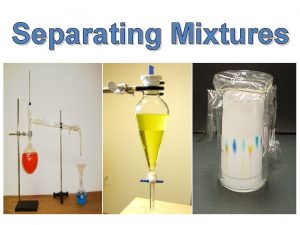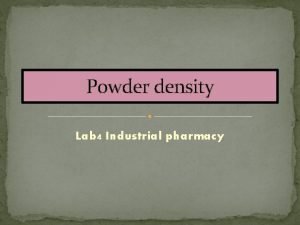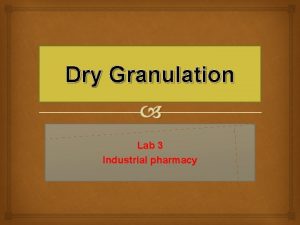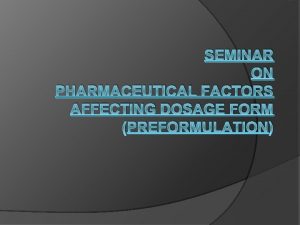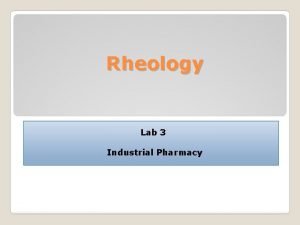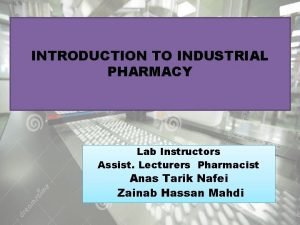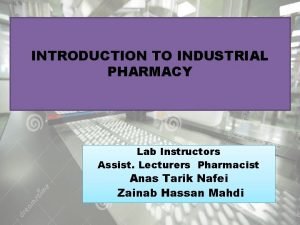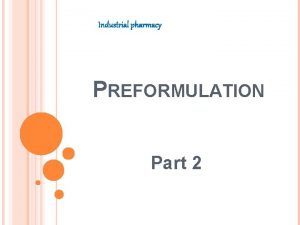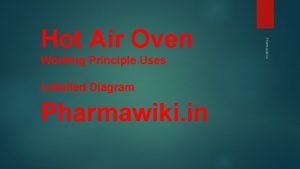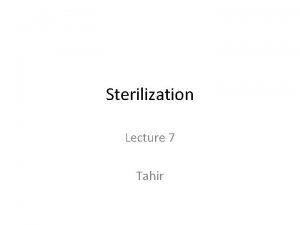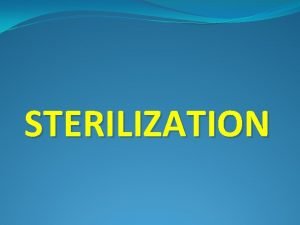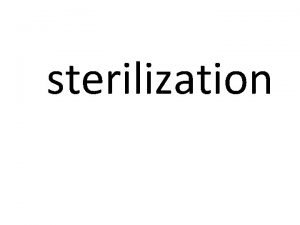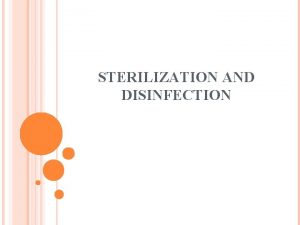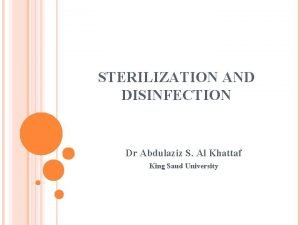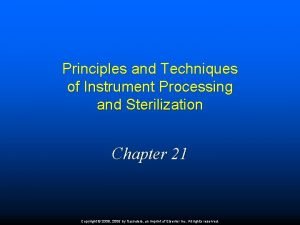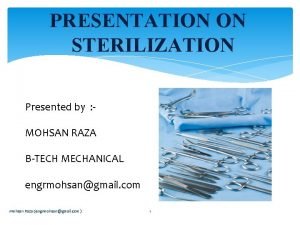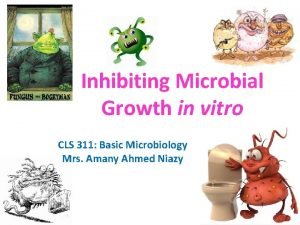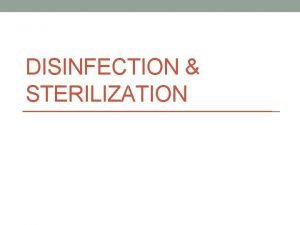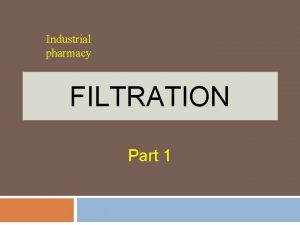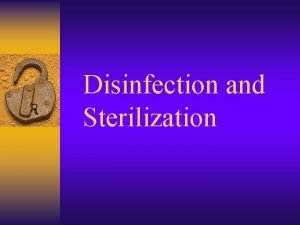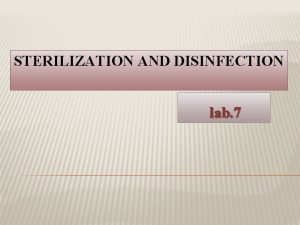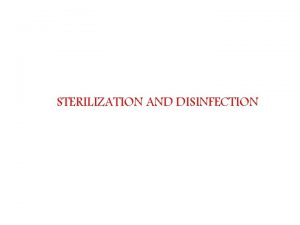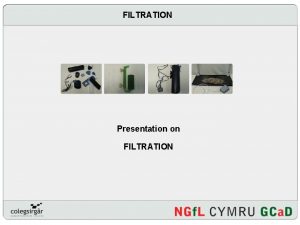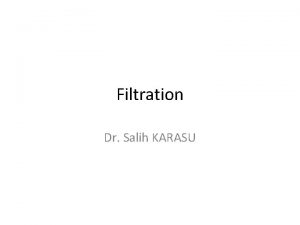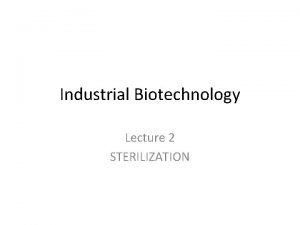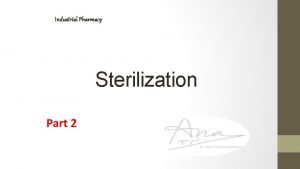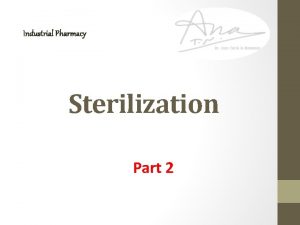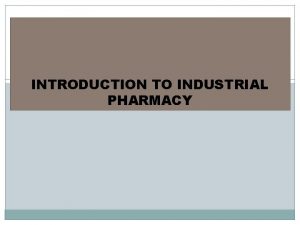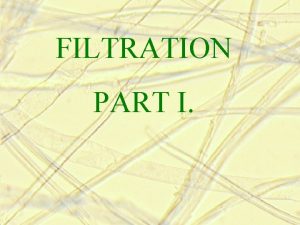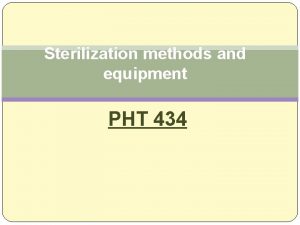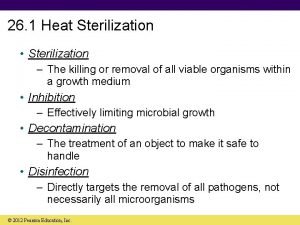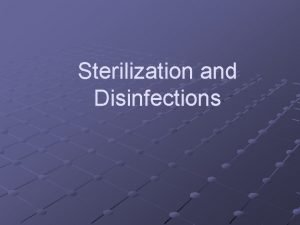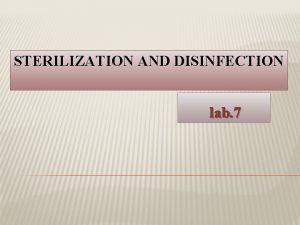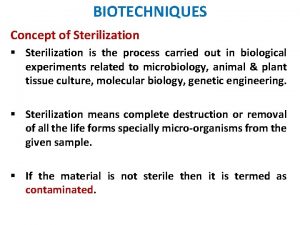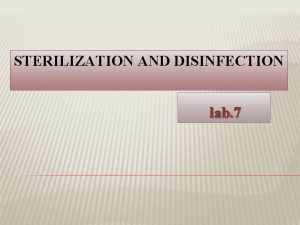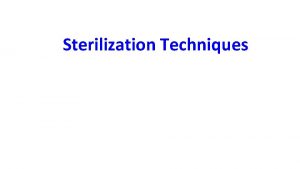Industrial Pharmacy Sterilization Part 3 Filtration used for






















- Slides: 22

Industrial Pharmacy Sterilization Part 3

Filtration used for: Removal of particles (M. O. ) from solutions and gases without the application of heat and not alter the solution or gas neither removing desired constituents nor imparting undesired components. Note: 1 - all currently in use filters with parenteral solutions and gases are of the membrane type (tissue-thin material) removing particles primarily by sieving. Mechanism: remove constituents from a solution due to the phenomenon of adsorption (surface phenomenon) which occurs during only the first portion of the filtration, then the surface of the filter is saturated with the adsorbed molecule or ion.

� The most common attack on the filter is due to the solvent properties of the vehicle (water) of certain parenteral products. 2 - Development of membrane filters composed of materials having high resistance to most pharmaceutical solvents has further reduced this problem. Composition of membrane filters: 1. Plastic polymers (cellulose acetate and nitrate, nylon, polyvinyl chloride, polycarbonate, polysulfone and Teflon). 2. Sintered metals (stainless steel and silver) used when highly durable characteristics are required.


Note: most membrane filters are disposable (problem of cleaning after use is limited to the reusable filter housing and support screen). Made of stainless steel or tough plastic polymers that are cleaned rather easily that might introduce contamination in subsequent use. Type of membranes: 1. Hydrophilic membranes: rendered hydrophilic by treatment with a surface active agent at the time of manufacture. Note: If this is not done, particularly at the lower porosities, an aqueous solution cannot be forced through the filter except under very high pressure. 2. Hydrophobic membranes: when nonwetting with water is desired as with non-aqueous solvents as ethanol and inert gases, the polymer is left in its

Function of Filters 1. 2. Membrane filters function primarily by sieving Screening particles from a solution or gas. retaining them on the filter surface Mechanism of depth filter (glass and paper): little entrapment within the filter medium because of the nature of membrane filters and their limited thickness. 3. Membrane filters by electrostatic attraction [filtration of dry gases, in which electrostatic charges tend to increase because of the frictional effect of the flowing gas]. The pores, or holes, through any filter medium consist of a range of sizes: � Filter with diameter of 0. 2 micron, the porosity used to effect sterilization, � Filter with diameter as large as 0. 5 micron and accordingly few in number so the probability of a microbial spore finding in those few pores

How to increase the probability of achieving a sterile filtrate? ? 1. Solution passed through a series of two 0. 2 -micron porosity filters. 2. Using 0. 1 -micron porosity filter but this would greatly reduce the flow rate. Problem: membrane filters function by sieving [particles in the solution may retained on the surface if the content is relatively high and plug the filter so that the flow of solution decreases and perhaps stops]. Solution: the solution processed by passing it through one or more prefilters, the first usually being a relatively porous depth filter. Avoid: prolong filtration time or high pressure differential, or frequent fluctuation of the pressure.

Liquid Flow Through a Filter The flow rate of a liquid through a filter is affected by: 1. Size of pores through filter 2. Pore volume (proportion of open space to solid matrix) 3. S. A. of filter 4. Pressure differential across filter 5. Viscosity of liquid. Problem 1: How to increase flow rate if there is a difficulty of increasing S. A. of filter. Solution: folded filter in a cartridge form is used large increase in surface area within a small overall dimension of the filter unit. Problem 2: How to decrease pressure differential with the preventing of negative pressure in the filtrate chamber as the vacuum may be drawn downstream of the filter. Solution: filtrations designed to render solutions sterile, positive pressure is applied on the liquid upstream of the filter using a gas filtered to be free from microorganisms.

Problem 3: Solutions having a high viscosity normally have a slow flow rate. Solution: the rate can be increased by warming the solution, thereby reducing its viscosity provided the warming does not have an adverse affect on the solution. Problem 4: High amount of solid matrix is in proportion to the pore spaces, the lower are the pore volume and the flow rate. Solution: as the flow rate through a filter is depending on the relative pore volume of the filter so all filters must have a lower amount of solid matrix that forms the framework for the pores.

Types of Filters �

Testing of Filters Testing the pore size and integrity of the filter membrane filters should be checked before use. 1. bubble point test [The least complicated method] A- Hydrophilic membrane: test is performed by applying air pressure, or other gas pressure, to the upstream side of a hydrophilic filter in which the pores are filled with water. The pressure is gradually increased until bubbles pass through the filter and are detected in a liquid downstream. Note: bubble point pressure is inversely proportional to the diameter of the pores, and thus is a measure of the largest pores. Even a pinhole or similar defect in the filter, bubbling occurs at a much lower pressure than expected. B- Hydrophobic membranes: filter is usually wet

C- cartridge-type filters (measure diffusion of air, or other gas, through the water-filled pores of the filter medium because of the large surface area). Mech. : Pressure is applied to the upstream side of the filter at approximately 10% of the bubble test pressure. Filtration rate is measured by the volume of the air collected downstream or by the loss of pressure from the upstream side as the air diffuses. 2. Microbial challenge test (direct test with respect to the ability of a filter to retain microorganisms) A standardized culture containing a large number of small microorganisms, such as Pseudomonas diminuta, is filtered. The objective: finding oversized pores in the filter by the challenge of a large number of small microorganisms. After filtration: the presence of bacteria in the filtrate

Aseptic Processing The objective of this process: 1. Sterilization of a solution by filtration provides an extremely clean solution, removing dirt particles as well as M. O. 2. Filtrate transferred from the receiver and subdivided into the individual final containers. 3. Accomplishing requires a rigidly controlled aseptic environment and technique. Application: solutions adversely affected by heat, may be the only way in which sterilization is accomplished.

Chemical Processes of Sterilization Gas Sterilization �

Sterilizing Process Sterilization with Et. O is validated procedure using a pressure chamber: 1. 2. 3. 4. 5. The material is placed in a room or chamber and exposed to a relative humidity of up to 98% for a period of 60 min or longer. Then placed in chamber previously heated to 55°C and an initial vacuum of 27 in. Hg is drawn. Et. O is introduced with moisture to achieve a relative humidity of 50 to 60% to the pressure required to give the desired concentration of ethylene oxide which is maintained throughout the exposure period (6 -24 h) Gas is exhausted and a vacuum of 25 inches Hg is drawn. Filtered air is then introduced into the chamber until atmospheric pressure is attained.

Factors affecting sterilization time with Et. O A heated chamber is decreasing the time required for this sterilization process. A temperature of 55°C has no adverse effect on most substances then a rise in temp of 17°C permits the shortening of the exposure period by about one half. 1. Moisture found to exert a significant effect on the sterilization process. A moisture up to 95% RH should be the first step in every sterilizing cycle as an aid in the distribution and absorption of moisture by the material to be sterilized then a relative humidity (RH) of 30% or more is essential for effective antibacterial activity. Note: M. O. must be hydrated if to be killed by Et. O within the usual cycle time. 2. The exposure conditions with Et. O conc. higher than the min. effective conc. of 450 mg/liter of chamber volume reduce the exposure period. Note: The conc. employed are directly related to the pressure of the various mixtures required to attain that conc. 3.

Note: liquid ethylene oxide is frequently used by vaporized into the sterilizing chamber previously evacuated to at least 28 in. Hg. How to evacuate of Et. O? ? Dissipation of Et. O from materials is accomplished at the end of a sterilizing cycle by the evacuation followed by a short period of aeration, that is, exposure to the normal atmosphere. Disadvantages: 1. Rubber, certain plastics, and leather-have a strong affinity for Et. O and may require prolonged aeration, as long as 12 to 24 hours, before items safely be used. 2. Tissue irritation may result if the Eto is not entirely dissipated. 3. Carcinogenic and mutagenic properties of Et. O and

Mechanism of Action of Ethylene oxide: exert lethal effect upon M. O. by alkylating essential metabolites, affecting particularly the reproductive process. The alkylation occurs by replacing an active hydrogen on sulfhydryl, amino, carboxyl, or hydroxyl groups with a hydroxyethyl radical. The altered metabolites are not available to the M. O. , and so it dies without reproducing. Limitation: Alkylation occur with drug molecules in liquid state so Et. O sterilization is limited Application: 1. 2. 3. 4. dry powders of substances are unaffected plastic materials, rubber goods, and delicate optical instruments. stainless steel equipment has a longer useful life when sterilized with ethylene oxide instead of steam. sterilize parenteral administration sets, hypodermic needles, plastic syringes due to effective penetrability of Et. O.

2. Beta-propiolactone. a. b. c. Nonflammable liquid at room temp. It has a low vapor pressure, but since it is bactericidal against a wide variety of M. O. at low conc. so no difficulty in obtaining bactericidal conc. of the vapor. It is an alkylating agent and has a mode of action against M. O. similar to Et. O. Sterilization process: vapor conc. of 2 to 4 mg/l of space are effective at a temp. not below 24°C and a RH of at least 70%, with an exposure period of at least 2 hrs. Uses: The penetrability of beta-propiolactone vapor found to be poor so sterilization of surfaces in large

Surface Disinfection The use of chemical disinfectants to reduce microbial population so that asepsis can be maintained in a limited, controlled environment. The effectiveness of a disinfectant depends on: A. nature of the surface B. nature and degree of contamination C. microbicidal activity of the agent. Important notes: 1. 2. Hard smooth surfaces are much easier to disinfect than rough porous ones. Most disinfectants are not effective against spores, only vegetative forms of M. O. killed so it is essential to select an agent that has been proven effective against the

1 - A germicides for smooth hard surfaces contain: 2% solution of one of the phenolic germicide cleaners for floors and walls, and 1: 1000 concentrations of quaternary ammonium solutions or 1 to 2% solutions of phenolic. 2 - A germicides for metallic object contain: 0. 2% sodium nitrite added to the quaternary ammonium solutions and 0. 5% sodium bicarbonate to the phenolic to prevent rusting. �Higher concentrations of disinfectants normally would be expected to be more effectively bactericidal.

 Constant rate filtration equation
Constant rate filtration equation Importance of separating mixtures
Importance of separating mixtures Bulk density in industrial pharmacy
Bulk density in industrial pharmacy Disadvantages of dry granulation
Disadvantages of dry granulation Preformulation definition in pharmacy
Preformulation definition in pharmacy Rheology lab
Rheology lab Industrial pharmacy definition
Industrial pharmacy definition Industrial pharmacy lab
Industrial pharmacy lab Preformulation studies in industrial pharmacy
Preformulation studies in industrial pharmacy Specially constructed stainless steel truck
Specially constructed stainless steel truck Well labelled diagram of hot air oven
Well labelled diagram of hot air oven Del factor in sterilization
Del factor in sterilization Sterilization by mechanical methods
Sterilization by mechanical methods Sterilization controls
Sterilization controls What is sterilization
What is sterilization Tyndallization
Tyndallization Principle of autoclave
Principle of autoclave Instrument processing area
Instrument processing area Gmail
Gmail Sterilization
Sterilization Forced sterilization
Forced sterilization I've gotten better
I've gotten better Sterilization quality control
Sterilization quality control

